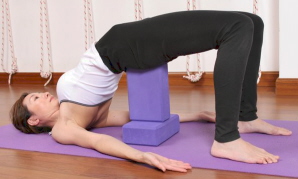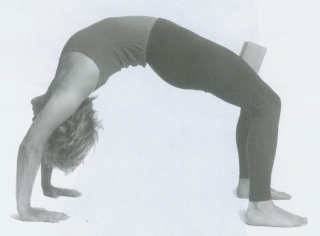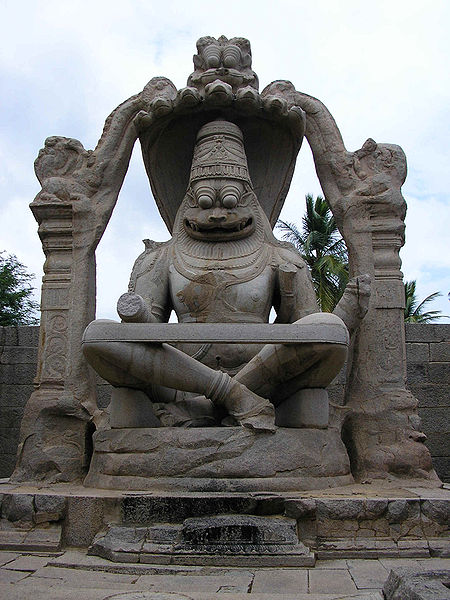Place a brick under
the sacrum helps to lift the hips and stay longer in Setu Bandha Sarvangasana:

Setu
Bandha Sarvangasana
or place a
brick between inner thighs in Urdhva Dhanurasana, helps to prevent legs
invariably drift to the side, and enhances the ability to lift the lower back:

Urdhva Dhanurasana
There are so many
other uses of the belt and brick which help us to improve the quality of the
asana.
 When
Mr. Iyengar was asked as to how he got the idea about the belt and brick, he
said that he had seen a statue of Narasimha located at Hampi, in the Southern
Indian state of Karnataka. This statue is in a yoga posture – Sukhasana. When
Mr. Iyengar was asked as to how he got the idea about the belt and brick, he
said that he had seen a statue of Narasimha located at Hampi, in the Southern
Indian state of Karnataka. This statue is in a yoga posture – Sukhasana.
Narasimha is the fourth incarnation
of Vishnu, one of Hinduism's
most popular deities.
Narasimha has a human-like
torso and a lower body, but with a lion-like face and claws. He is known primarily as the
'Great Protector', who specifically defends and protects his devotees at the
times of need.
This monolithic sculpture of Narasimha is a 6.7 metre tall and about 500 years
old.This statue is in a
yogic posture with a cloth/belt wrapped around his knees and bricks underneath
his thighs. Mr. Iyengar was thinking about what were these belt and bricks doing
there? Did they use props even then? Then Mr. Iyengar went through some ancient
literatures and found that it was clearly mentioned in some text that about 800
years ago, about the story of this half-man/half-lion, and also mentioned that
Narasimha has a yoga belt over his crossed legs and bricks under his thighs. And
the text further states that in this posture, Narasimha gives the impression
that he is ready to teach his devotees the secrets of yoga that require
knowledge about the firm control of the 5 pranas and 5 senses of perception,
which is a pre-requisite to be able to mediate, and also states that the belt
and bricks depict how the anger and ferocious form Narasimha is calmed.
The use of props is
as ancient as some of the yogic texts. We must thank Mr. Iyengar not only for
reviving interest of the common man in yoga but also for rediscovering this belt
and brick which would have been lost if not for his sharp observation and his
vision.
Namaste,
Kenny Choi
Josephine Yu |


